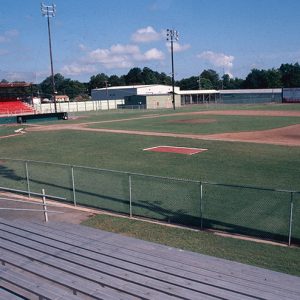calsfoundation@cals.org
Taylor Field
aka: Taylor Memorial Field
Taylor Field, located at 1201 East 16th Street in Pine Bluff (Jefferson County), is a regulation-size baseball field featuring a U-shaped grandstand designed by architect Mitchell Seligman. Taylor Field was constructed in 1939 with assistance from the Works Progress Administration (WPA), a Depression-era federal relief agency. It was listed on the National Register of Historic Places on January 21, 2010.
The Pine Bluff Judges of the Pine Bluff Baseball Club played their games at Missouri Pacific Park, built in 1930, until fire severely damaged it a year later. A new structure was erected, but after seven years it was in serious disrepair, leading local baseball boosters to turn to the WPA for assistance in constructing a new field and grandstand. Pinchback Taylor Sr. acquired land for a new ball field and paid $900 in back taxes before donating it to the city of Pine Bluff to ensure it had a clear title.
Mayor James P. McGauphy applied for WPA support, and the federal agency approved a project “to construct a recreational field…including developing tennis courts and baseball, and football fields;…grandstand, and facilities for horse show exhibits and public speaking” along with related work. Ultimately, only the baseball field would be constructed.
In addition to seeking a new ball field, Pine Bluff baseball boosters wanted a professional minor league team in the city, and representatives of the Pine Bluff Judges met with Brooklyn Dodgers vice president Larry P. McPhail in early 1939 to have the Judges included as a farm team for the Dodgers. McPhail agreed, with the caveat that Pine Bluff provide a professional-quality baseball field. The city created a commission (now called the Taylor Field Commission) to raise funds and oversee the new baseball field. It was decided to name the facility Taylor Field in honor of Pinchback Taylor Sr., who also was elected president of the commission.
Pine Bluff architect Mitchell Seligman designed the new baseball stadium, which had a U-shaped structure that could hold up to 2,400 fans. City officials and business leaders scoured Pine Bluff for building materials, acquiring bricks and lumber after the razing of the Miller Theater on State Street, which Mayor James P. McGauphy called “the city’s largest contribution to the Taylor Field project.”
The playing field was ready in time for the April opening day of the Cotton States League season in which the Judges played the Hot Springs Bathers, though temporary grandstands for 1,500 had to be erected; Pine Bluff celebrated with a parade down Main Street of players from both teams and the high school marching band. The concrete central section of the permanent grandstand was finished in time for the Judges’ May 15, 1939, game against the Greenwood Crackers. The project was basically completed by July. Taylor Field hosted professional baseball until 1955 and in 1996, when the short-lived Pine Bluff Locomotives played there. The field also was the scene for the 1948 kickoff of Sidney McMath’s gubernatorial campaign and 1950 reelection campaign.
In the twenty-first century, Taylor Field remains the home field for the Pine Bluff High School Zebras baseball team. It has changed little since its 1939 construction. Taylor Field in Pine Bluff and Lamar Porter Athletic Field in Little Rock (Pulaski County) are the only surviving WPA-built baseball stadiums in Arkansas.
For additional information:
Hope, Holly. An Ambition to be Preferred: New Deal Recovery Efforts and Architecture in Arkansas, 1933–1943. Little Rock: Arkansas Historic Preservation Program, 2006. Online at http://www.arkansaspreservation.com/News-and-Events/publications (accessed April 29, 2020).
Lea, George A., III. “Taylor Field.” National Register of Historic Places registration form. On file at Arkansas Historic Preservation Program, Little Rock, Arkansas. Online at http://www.arkansaspreservation.com/National-Register-Listings/PDF/JE0912.nr.pdf (accessed April 29, 2020).
WPA Central Office Files, 1939–1942, Ala.–Arkansas, Roll 2. Arkansas State Archives, Little Rock, Arkansas.
Mark K. Christ
Central Arkansas Library System
 Early Twentieth Century, 1901 through 1940
Early Twentieth Century, 1901 through 1940 Historic Preservation
Historic Preservation Recreation and Sports
Recreation and Sports Taylor Field
Taylor Field 



Comments
No comments on this entry yet.